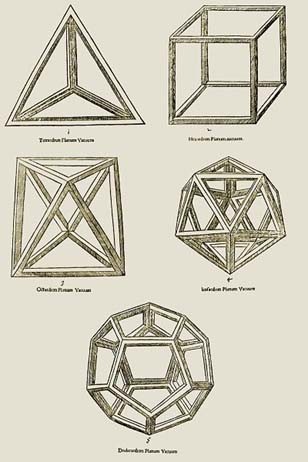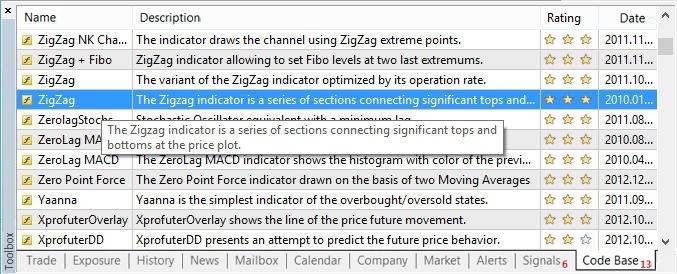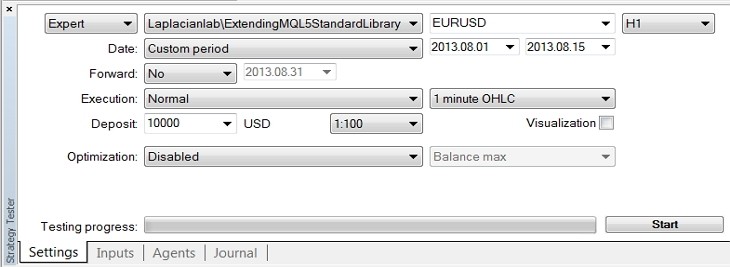
Extending MQL5 Standard Library and Reusing Code
Introduction
MQL5 Standard Library is an object-oriented framework composed of a set of ready-to-use classes which makes your life easier as a developer. Nevertheless, it does not implement all the needs of all developers around the world, so if you feel that you need some more custom stuff, you can take a step further and expand. This article takes you through integrating MetaQuotes' Zig-Zag technical indicator into the Standard Library. We will be inspired by MetaQuotes' design philosophy in order to achieve our goal.
In a nutshell, MQL5 API is intended for you to benefit from code reuse, reliability, flexibility and easy maintenance. This is what the theory says, but beyond all this, if you plan to continue to advance in MQL5 and develop more sophisticated things, such as multi-currency Experts Advisors, first you should be able to code in the Standard Library way so that your apps are guaranteed a successful life.
As your EAs and indicators become more and more complex, it is more necessary to master the concepts involved in a framework development. As a real life example, it is my personal need to develop a complex multi-currency EA which dictates the need of strengthening the base of my project from scratch.

Figure 1. Regular polyhedra are perfect objects. They depict well the approach of building apps on solid concepts
1. ZigZag Download
We start by downloading MetaQuotes' ZigZag indicator, which is available in Code Base, from our MetaTrader 5 Terminal. This will create the files Indicators\zigzag.mq5 and Indicators\zigzag.ex5.
Figure 2. We start downloading MetaQuotes' ZigZag from our MetaTrader 5 Terminal
I attach here those lines of Indicators\zigzag.mq5 containing the indicator's input parameters, global variables and the OnInit() handler. I only put this part because the entire file has 298 lines of code. This is simply for convenience and the understanding of the bigger picture we are talking about below.
//+------------------------------------------------------------------+ //| ZigZag.mq5 | //| Copyright 2009, MetaQuotes Software Corp. | //| https://www.mql5.com | //+------------------------------------------------------------------+ #property copyright "2009, MetaQuotes Software Corp." #property link "https://www.mql5.com" #property version "1.00" #property indicator_chart_window #property indicator_buffers 3 #property indicator_plots 1 //---- plot Zigzag #property indicator_label1 "Zigzag" #property indicator_type1 DRAW_SECTION #property indicator_color1 Red #property indicator_style1 STYLE_SOLID #property indicator_width1 1 //--- input parameters input int ExtDepth=12; input int ExtDeviation=5; input int ExtBackstep=3; //--- indicator buffers double ZigzagBuffer[]; // main buffer double HighMapBuffer[]; // highs double LowMapBuffer[]; // lows int level=3; // recounting depth double deviation; // deviation in points //+------------------------------------------------------------------+ //| Custom indicator initialization function | //+------------------------------------------------------------------+ int OnInit() { //--- indicator buffers mapping SetIndexBuffer(0,ZigzagBuffer,INDICATOR_DATA); SetIndexBuffer(1,HighMapBuffer,INDICATOR_CALCULATIONS); SetIndexBuffer(2,LowMapBuffer,INDICATOR_CALCULATIONS); //--- set short name and digits PlotIndexSetString(0,PLOT_LABEL,"ZigZag("+(string)ExtDepth+","+(string)ExtDeviation+","+(string)ExtBackstep+")"); IndicatorSetInteger(INDICATOR_DIGITS,_Digits); //--- set empty value PlotIndexSetDouble(0,PLOT_EMPTY_VALUE,0.0); //--- to use in cycle deviation=ExtDeviation*_Point; //--- return(INIT_SUCCEEDED); }
2. Quick Top-Down Overview
Let's now take a top-down approach to think of our new object-oriented ZigZag indicator that we want to integrate into MQL5 Standard Library. This means that first we have to look at the whole system and then analyze the smaller parts of it. So why don't we code a couple of dummy EAs in order to see the bigger picture? Let's write a procedural styled Expert Advisor together with its object-oriented version.
2.1. ZigZag Out of the Box
Intermediate MQL5 developers would probably use the ZigZag indicator in their EAs like this:
//+----------------------------------------------------------------------+ //| ExpertOriginalZigZag.mq5 | //| Copyright © 2013, Laplacianlab - Jordi Bassagañas | //+----------------------------------------------------------------------+ //--- EA properties #property copyright "Copyright © 2013, Laplacianlab - Jordi Bassagañas" #property link "https://www.mql5.com/en/articles" #property version "1.00" #property description "This dummy Expert Advisor is just for showing how to use the original MetaQuotes' ZigZag indicator." //--- EA inputs input ENUM_TIMEFRAMES EAPeriod=PERIOD_H1; input string CurrencyPair="EURUSD"; //--- global variables int zigZagHandle; double zigZagBuffer[]; double zigZagHigh[]; double zigZagLow[]; //+------------------------------------------------------------------+ //| Expert initialization function | //+------------------------------------------------------------------+ int OnInit() { zigZagHandle=iCustom(CurrencyPair,EAPeriod,"zigzag",12,5,3); ArraySetAsSeries(zigZagBuffer,true); ArraySetAsSeries(zigZagHigh,true); ArraySetAsSeries(zigZagLow,true); return(0); } //+------------------------------------------------------------------+ //| Expert deinitialization function | //+------------------------------------------------------------------+ void OnDeinit(const int reason) { IndicatorRelease(zigZagHandle); ArrayFree(zigZagBuffer); ArrayFree(zigZagHigh); ArrayFree(zigZagLow); } //+------------------------------------------------------------------+ //| Expert tick function | //+------------------------------------------------------------------+ void OnTick() { //--- refresh data if(CopyBuffer(zigZagHandle,0,0,2,zigZagBuffer)<0) { Print("Can't copy ZigZag buffer 0!"); return; } if(CopyBuffer(zigZagHandle,1,0,2,zigZagHigh)<0) { Print("Can't copy ZigZag buffer 1!"); return; } if(CopyBuffer(zigZagHandle,2,0,2,zigZagLow)<0) { Print("Can't copy ZigZag buffer 2!"); return; } //--- print values if(zigZagBuffer[0]!=0) Print("zigZagBuffer[0]: ", zigZagBuffer[0]); if(zigZagHigh[0]!=0) Print("zigZagHigh[0]: ", zigZagHigh[0]); if(zigZagLow[0]!=0) Print("zigZagLow[0]: ", zigZagLow[0]); } //+------------------------------------------------------------------+
2.2. ZigZag Integrated into the Standard Library
On the other hand, advanced MQL5 developers will want to work with ZigZag indicator just as they already do with the Standard Library indicators, this way:
//+----------------------------------------------------------------------+ //| ExpertOOZigZag.mq5 | //| Copyright © 2013, Laplacianlab - Jordi Bassagañas | //+----------------------------------------------------------------------+ #include <..\Include\Indicators\Custom\Trend.mqh> //--- EA properties #property copyright "Copyright © 2013, Laplacianlab - Jordi Bassagañas" #property link "https://www.mql5.com/en/articles" #property version "1.00" #property description "This dummy Expert Advisor is just for showing how to use the object-oriented version of MetaQuotes' ZigZag indicator." //--- EA inputs input ENUM_TIMEFRAMES EAPeriod=PERIOD_H1; input string CurrencyPair="EURUSD"; //--- global variables CiZigZag *ciZigZag; //+------------------------------------------------------------------+ //| Expert initialization function | //+------------------------------------------------------------------+ int OnInit() { ciZigZag=new CiZigZag; ciZigZag.Create(CurrencyPair,EAPeriod,12,5,3); return(0); } //+------------------------------------------------------------------+ //| Expert deinitialization function | //+------------------------------------------------------------------+ void OnDeinit(const int reason) { delete(ciZigZag); } //+------------------------------------------------------------------+ //| Expert tick function | //+------------------------------------------------------------------+ void OnTick() { //--- refresh data ciZigZag.Refresh(); //--- print values if(ciZigZag.ZigZag(0)!=0) Print("OO ZigZag buffer: ", ciZigZag.ZigZag(0)); if(ciZigZag.High(0)!=0) Print("OO ZigZag high: ", ciZigZag.High(0)); if(ciZigZag.Low(0)!=0) Print("OO ZigZag low: ",ciZigZag.Low(0)); } //+------------------------------------------------------------------+
2.3. Conclusion
The second solution is better because it is object-oriented. Once the OO classes have been developed, it is intuitive to observe that it is much easier interacting with the Zig-Zag's object-oriented funcionality than working with its procedural counterpart. Let's briefly recall, however, the advantages we benefit from when working with an object oriented library:
- OOP makes it easy to model problems.
- OOP makes it easy to reuse code, which in turn benefits cost, reliability, flexibility and maintenance.
This paradigm enables the creation of ADTs (Abstract Data Types). An ADT is an abstraction of the traditional concept of data type, which is present in all programming languages.

Figure 3. Regular icosahedron. Building our apps on solid concepts is a quality guarantee that makes our designs persist in time
3. Integrating our new OO ZigZag into MQL5 Standard Library
As I said in the introduction of this article, we are being inspired by MetaQuotes' object-oriented style to build our new set of classes intended for wrapping the ZigZag downloaded before. This is easy, we just have to take a look at the files inside Include\Indicators and study and understand some of the ideas that lay behind MQL5 Standard Library. When you look at what there is inside MetaQuotes' Trend.mqh you will soon realize that it is full of classes representing some technical indicators: ADX, Bollinger Bands, SAR, Moving Averages, etc. All these classes inherit from CIndicator. So let's implement this scheme. By the way, extending the new OO indicator from MQL5's class CiCustom would have been another alternative to implement this exercise.
Let's begin by creating the new folder Include\Indicators\Custom and, right after, the new file Include\Indicators\Custom\Trend.mqh in order for us to code there our own technical indicators, just as MetaQuotes does in its Include\Indicators\Trend.mqh. Here is our extending file Include\Indicators\Custom\Trend.mqh already implemented. I will discuss below some technical aspects needed to code it.
//+------------------------------------------------------------------+ //| Include\Indicators\Custom\Trend.mqh | //| Copyright 2013, Laplacianlab - Jordi Bassagañas | //| https://www.mql5.com/en/users/laplacianlab | //+------------------------------------------------------------------+ #include <..\Include\Indicators\Indicator.mqh> //+------------------------------------------------------------------+ //| Class CiZigZag. | //| Purpose: Class of the "ZigZag" indicator. | //| Derives from class CIndicator. | //+------------------------------------------------------------------+ class CiZigZag : public CIndicator { protected: int m_depth; int m_deviation; int m_backstep; public: CiZigZag(void); ~CiZigZag(void); //--- methods of access to protected data int Depth(void) const { return(m_depth); } int Deviation(void) const { return(m_deviation); } int Backstep(void) const { return(m_backstep); } //--- method of creation bool Create(const string symbol,const ENUM_TIMEFRAMES period, const int depth,const int deviation_create,const int backstep); //--- methods of access to indicator data double ZigZag(const int index) const; double High(const int index) const; double Low(const int index) const; //--- method of identifying virtual int Type(void) const { return(IND_CUSTOM); } protected: //--- methods of tuning virtual bool Initialize(const string symbol,const ENUM_TIMEFRAMES period,const int num_params,const MqlParam ¶ms[]); bool Initialize(const string symbol,const ENUM_TIMEFRAMES period, const int depth,const int deviation_init,const int backstep); }; //+------------------------------------------------------------------+ //| Constructor | //+------------------------------------------------------------------+ CiZigZag::CiZigZag(void) : m_depth(-1), m_deviation(-1), m_backstep(-1) { } //+------------------------------------------------------------------+ //| Destructor | //+------------------------------------------------------------------+ CiZigZag::~CiZigZag(void) { } //+------------------------------------------------------------------+ //| Create indicator "Zig Zag" | //+------------------------------------------------------------------+ bool CiZigZag::Create(const string symbol,const ENUM_TIMEFRAMES period, const int depth,const int deviation_create,const int backstep) { //--- check history if(!SetSymbolPeriod(symbol,period)) return(false); //--- create m_handle=iCustom(symbol,period,"zigzag",depth,deviation_create,backstep); //--- check result if(m_handle==INVALID_HANDLE) return(false); //--- indicator successfully created if(!Initialize(symbol,period,depth,deviation_create,backstep)) { //--- initialization failed IndicatorRelease(m_handle); m_handle=INVALID_HANDLE; return(false); } //--- ok return(true); } //+------------------------------------------------------------------+ //| Initialize the indicator with universal parameters | //+------------------------------------------------------------------+ bool CiZigZag::Initialize(const string symbol,const ENUM_TIMEFRAMES period,const int num_params,const MqlParam ¶ms[]) { return(Initialize(symbol,period,(int)params[0].integer_value,(int)params[1].integer_value,(int)params[2].integer_value)); } //+------------------------------------------------------------------+ //| Initialize indicator with the special parameters | //+------------------------------------------------------------------+ bool CiZigZag::Initialize(const string symbol,const ENUM_TIMEFRAMES period, const int depth,const int deviation_init,const int backstep) { if(CreateBuffers(symbol,period,3)) { //--- string of status of drawing m_name ="ZigZag"; m_status="("+symbol+","+PeriodDescription()+","+ IntegerToString(depth)+","+IntegerToString(deviation_init)+","+ IntegerToString(backstep)+") H="+IntegerToString(m_handle); //--- save settings m_depth=depth; m_deviation=deviation_init; m_backstep=backstep; //--- create buffers ((CIndicatorBuffer*)At(0)).Name("ZIGZAG"); ((CIndicatorBuffer*)At(1)).Name("HIGH"); ((CIndicatorBuffer*)At(2)).Name("LOW"); //--- ok return(true); } //--- error return(false); } //+------------------------------------------------------------------+ //| Access to ZigZag buffer of "Zig Zag" | //+------------------------------------------------------------------+ double CiZigZag::ZigZag(const int index) const { CIndicatorBuffer *buffer=At(0); //--- check if(buffer==NULL) return(EMPTY_VALUE); //--- return(buffer.At(index)); } //+------------------------------------------------------------------+ //| Access to High buffer of "Zig Zag" | //+------------------------------------------------------------------+ double CiZigZag::High(const int index) const { CIndicatorBuffer *buffer=At(1); //--- check if(buffer==NULL) return(EMPTY_VALUE); //--- return(buffer.At(index)); } //+------------------------------------------------------------------+ //| Access to Low buffer of "Zig Zag" | //+------------------------------------------------------------------+ double CiZigZag::Low(const int index) const { CIndicatorBuffer *buffer=At(2); //--- check if(buffer==NULL) return(EMPTY_VALUE); //--- return(buffer.At(index)); } //+------------------------------------------------------------------+
3.1. Object-Oriented Encapsulation
OO encapsulation is a good programming practice meaning that data member of objects can only be modified by the operations defined for them. All the classes defined in MetaQuotes's Trend.mqh implement this idea, so we are doing the same.
On the one hand, there are CiZigZag's specific protected properties:
protected: int m_depth; int m_deviation; int m_backstep;
Subsequently, there is CiZigZag's public interface for accessing from outside a given object of CiZigZag type the protected properties defined above:
public: //--- methods of access to protected data int Depth(void) const { return(m_depth); } int Deviation(void) const { return(m_deviation); } int Backstep(void) const { return(m_backstep); }
This is a security measure for isolating objects. This encapsulation protects against arbitrary modifications carried out by someone or something that is not allowed to access objects data.
3.2. Accessing ZigZag's Data
As seen in the first section of this article, the source code file named zigzag.mq5 creates three buffers:
//--- indicator buffers mapping SetIndexBuffer(0,ZigzagBuffer,INDICATOR_DATA); SetIndexBuffer(1,HighMapBuffer,INDICATOR_CALCULATIONS); SetIndexBuffer(2,LowMapBuffer,INDICATOR_CALCULATIONS);
Through object-oriented encapsulation, CiZigZag's methods ZigZag(const int index), High(const int index) and Low(const int index) return the indicator buffers which have previously been created in the initialization method. It is important to note that the object-oriented wrapper CIndicatorBuffer is defined in MQL5's class Include\Indicators\Indicator.mqh. CIndicatorBuffer is the core piece of these three methods. We are already immersed in MQL5 API!
As an example here, it is the code for accessing CiZigZag's High buffer:
//+------------------------------------------------------------------+ //| Access to High buffer of "Zig Zag" | //+------------------------------------------------------------------+ double CiZigZag::High(const int index) const { CIndicatorBuffer *buffer=At(1); //--- check if(buffer==NULL) return(EMPTY_VALUE); //--- return(buffer.At(index)); }
3.3. Polymorphism, method overloading and virtual functions
In the previous section we briefly discussed the topic of encapsulation which is one of the most important features of object-oriented programming. Well, the classes contained in Include\Indicators\Indicator.mqh and the file Include\Indicators\Custom\Trend.mqh deal with another two aspects of the OOP paradigm, polymorphism and method overloading.
Polymorphism has the ability to access a diverse range of methods through the same interface. This way, a given identifier can take several forms depending on the context in which it is located. Polymorphism requires the inheritance mechanism so that it can be implemented. On the other hand, method overloading is another OOP feature that allows creating several methods sharing the same name but with different parameter declarations.
This is a very short introduction. There is not enough space in this article to discuss these subjects, so delving into them is an exercise left for you. Please, read the MQL5 sections Polymorphism and Overload. In any case, we see the Standard Library implement all OOP features, consequently, the better we know them the better we can extend the API to suit our needs.
With all that was said, there is only one more thing to be noted. MQL5 implements polymorphism by a mechanism called Virtual Functions. Once again, please, read the MQL5 section Virtual Functions to understand how it works.
This is why we code CiZigZag's initialization method this way:
//+------------------------------------------------------------------+ //| Initialize the indicator with universal parameters | //+------------------------------------------------------------------+ bool CiZigZag::Initialize(const string symbol,const ENUM_TIMEFRAMES period,const int num_params,const MqlParam ¶ms[]) { return(Initialize(symbol,period,(int)params[0].integer_value,(int)params[1].integer_value,(int)params[2].integer_value)); } //+------------------------------------------------------------------+ //| Initialize indicator with the special parameters | //+------------------------------------------------------------------+ bool CiZigZag::Initialize(const string symbol,const ENUM_TIMEFRAMES period, const int depth,const int deviation_init,const int backstep) { if(CreateBuffers(symbol,period,3)) { //--- string of status of drawing m_name ="ZigZag"; m_status="("+symbol+","+PeriodDescription()+","+ IntegerToString(depth)+","+IntegerToString(deviation_init)+","+ IntegerToString(backstep)+") H="+IntegerToString(m_handle); //--- save settings m_depth=depth; m_deviation=deviation_init; m_backstep=backstep; //--- create buffers ((CIndicatorBuffer*)At(0)).Name("ZIGZAG"); ((CIndicatorBuffer*)At(1)).Name("HIGH"); ((CIndicatorBuffer*)At(2)).Name("LOW"); //--- ok return(true); } //--- error return(false); }
4. Testing the new OO ZigZag, already available in the Standard Library
Of course, before using the extensions developed by you in your OO developments, you should first ensure that they work as expected. It is recommended to run a comprehensive set of tests on your new custom components. For simplicity issues, however, we'll now run a simple test on the three main methods of CiZigZag, that is to say, ZigZag(const int index), High(const int index) and Low(const int index).
We will just print the values calculated by those three methods on every EA's tick and then compare the output generated by ExpertOriginalZigZag.ex5, the dummy procedural EA, with the output generated by ExpertOOZigZag.ex5, the dummy object-oriented EA. Whenever both outputs obtained are the same, we can conclude that the new extension is OK, we can take for good our OO ZigZag integrated into MQL5 API.

Figure 4. We are comparing the output generated by ExpertOriginalZigZag.ex5 with the output generated by ExpertOOZigZag.ex5
Therefore we run both ExpertOriginalZigZag.ex5 and ExpertOOZigZag.ex5, the two EAs presented at the beginning of this article, in the Strategy Tester with the following parameters set:
- Symbol: EURUSD, H1
- Date: Custom period, from 2013.08.01 to 2013.08.15
- Execution: Normal, 1 Minute OHLC
- Deposit: 10000 USD, 1:100
- Optimization: None
As both robots print the same results we conclude that our CiZigZag is well implemented, so we can use it in our developments from now on.
Log generated by ExpertOriginalZigZag.ex5:
DE 0 18:45:39 ExpertOriginalZigZag (EURUSD,H1) 2013.08.01 08:50:40 zigZagBuffer[0]: 1.32657 ML 0 18:45:39 ExpertOriginalZigZag (EURUSD,H1) 2013.08.01 08:50:40 zigZagLow[0]: 1.32657 FL 0 18:45:39 ExpertOriginalZigZag (EURUSD,H1) 2013.08.01 08:50:59 zigZagBuffer[0]: 1.32657 GE 0 18:45:39 ExpertOriginalZigZag (EURUSD,H1) 2013.08.01 08:50:59 zigZagLow[0]: 1.32657 KS 0 18:45:39 ExpertOriginalZigZag (EURUSD,H1) 2013.08.01 08:51:00 zigZagBuffer[0]: 1.32657 FR 0 18:45:39 ExpertOriginalZigZag (EURUSD,H1) 2013.08.01 08:51:00 zigZagLow[0]: 1.32657 GK 0 18:45:39 ExpertOriginalZigZag (EURUSD,H1) 2013.08.01 08:51:20 zigZagBuffer[0]: 1.32653 RJ 0 18:45:39 ExpertOriginalZigZag (EURUSD,H1) 2013.08.01 08:51:20 zigZagLow[0]: 1.32653 OR 0 18:45:39 ExpertOriginalZigZag (EURUSD,H1) 2013.08.01 08:51:40 zigZagBuffer[0]: 1.32653 FS 0 18:45:39 ExpertOriginalZigZag (EURUSD,H1) 2013.08.01 08:51:40 zigZagLow[0]: 1.32653 QJ 0 18:45:39 ExpertOriginalZigZag (EURUSD,H1) 2013.08.01 08:51:59 zigZagBuffer[0]: 1.32653 PH 0 18:45:39 ExpertOriginalZigZag (EURUSD,H1) 2013.08.01 08:51:59 zigZagLow[0]: 1.32653 JQ 0 18:45:39 ExpertOriginalZigZag (EURUSD,H1) 2013.08.01 08:52:00 zigZagBuffer[0]: 1.32653 KP 0 18:45:39 ExpertOriginalZigZag (EURUSD,H1) 2013.08.01 08:52:00 zigZagLow[0]: 1.32653 RH 0 18:45:39 ExpertOriginalZigZag (EURUSD,H1) 2013.08.01 08:52:20 zigZagBuffer[0]: 1.32653 GI 0 18:45:39 ExpertOriginalZigZag (EURUSD,H1) 2013.08.01 08:52:20 zigZagLow[0]: 1.32653 GP 0 18:45:39 ExpertOriginalZigZag (EURUSD,H1) 2013.08.01 08:52:40 zigZagBuffer[0]: 1.32614 // More data here!..
Log generated by ExpertOOZigZag.ex5:
RP 0 18:48:02 ExpertOOZigZag (EURUSD,H1) 2013.08.01 08:50:40 OO ZigZag buffer(0): 1.32657 HQ 0 18:48:02 ExpertOOZigZag (EURUSD,H1) 2013.08.01 08:50:40 OO ZigZag low(0): 1.32657 DI 0 18:48:02 ExpertOOZigZag (EURUSD,H1) 2013.08.01 08:50:59 OO ZigZag buffer(0): 1.32657 RH 0 18:48:02 ExpertOOZigZag (EURUSD,H1) 2013.08.01 08:50:59 OO ZigZag low(0): 1.32657 QR 0 18:48:02 ExpertOOZigZag (EURUSD,H1) 2013.08.01 08:51:00 OO ZigZag buffer(0): 1.32657 GS 0 18:48:02 ExpertOOZigZag (EURUSD,H1) 2013.08.01 08:51:00 OO ZigZag low(0): 1.32657 IK 0 18:48:02 ExpertOOZigZag (EURUSD,H1) 2013.08.01 08:51:20 OO ZigZag buffer(0): 1.32653 GJ 0 18:48:02 ExpertOOZigZag (EURUSD,H1) 2013.08.01 08:51:20 OO ZigZag low(0): 1.32653 EL 0 18:48:02 ExpertOOZigZag (EURUSD,H1) 2013.08.01 08:51:40 OO ZigZag buffer(0): 1.32653 OD 0 18:48:02 ExpertOOZigZag (EURUSD,H1) 2013.08.01 08:51:40 OO ZigZag low(0): 1.32653 OE 0 18:48:02 ExpertOOZigZag (EURUSD,H1) 2013.08.01 08:51:59 OO ZigZag buffer(0): 1.32653 IO 0 18:48:02 ExpertOOZigZag (EURUSD,H1) 2013.08.01 08:51:59 OO ZigZag low(0): 1.32653 DN 0 18:48:02 ExpertOOZigZag (EURUSD,H1) 2013.08.01 08:52:00 OO ZigZag buffer(0): 1.32653 RF 0 18:48:02 ExpertOOZigZag (EURUSD,H1) 2013.08.01 08:52:00 OO ZigZag low(0): 1.32653 PP 0 18:48:02 ExpertOOZigZag (EURUSD,H1) 2013.08.01 08:52:20 OO ZigZag buffer(0): 1.32653 RQ 0 18:48:02 ExpertOOZigZag (EURUSD,H1) 2013.08.01 08:52:20 OO ZigZag low(0): 1.32653 MI 0 18:48:02 ExpertOOZigZag (EURUSD,H1) 2013.08.01 08:52:40 OO ZigZag buffer(0): 1.32614 // More data here!..
Conclusion
MQL5 Standard Library makes your life easier as a developer. Nevertheless, it cannot implement all the needs of all developers around the world, so there will always be some point where you will need to create your custom stuff. As your EAs and indicators become more and more complex, it is more necessary to master the concepts involved in a framework development. Extending MQL5 Standard Library is a quality guarantee for your applications to have a successful life.
We have taken advantage from code reuse by first downloading the ZigZag indicator from Code Base. Once available in our MetaTrader 5 Terminal, we took a top-down approach in order to start thinking of our new object-oriented ZigZag indicator. We had a general look at the whole system and then continued analyzing. In the first phase of the development we compared a dummy EA using the procedural styled ZigZag indicator with its object-oriented counterpart.
We wrapped the ZigZag indicator into an object-oriented class which was designed according to MetaQuotes's design philosophy, the same applied for building the Standard Library. And finally we run some simple tests concluding that our new CiZigZag wrapper, already integrated into MQL5 API, is well implemented.
 Creating Neural Network EAs Using MQL5 Wizard and Hlaiman EA Generator
Creating Neural Network EAs Using MQL5 Wizard and Hlaiman EA Generator
 Expert Advisor for Trading in the Channel
Expert Advisor for Trading in the Channel
 Trading Signal Generator Based on a Custom Indicator
Trading Signal Generator Based on a Custom Indicator
- Free trading apps
- Over 8,000 signals for copying
- Economic news for exploring financial markets
You agree to website policy and terms of use
Am I understanding you correctly???
It turns out that it is necessary to copy the whole history on each tick?1. You can do it at the opening of a new bar
2. Why do you need to get all indicator values every time, and at the same time take care of the indexing direction? What is the task at all?
Why wrapping a simple indicator into a class if it is used later either in a chart or via iCustom?
Второе решение лучше, потому что является объектно-ориентированным
OOP for OOP's sake, okay.
1. It is possible to open a new bar
2. Why do you need to get all the indicator values every time, and at the same time care about the indexing direction? What is the task at all?
The problem was solved by the loop conditions, now everything works as desired. thanks!
Why wrapping a simple indicator into a class if it is used later either in a chart or via iCustom?
OOP for OOP's sake, okay.
That's right)))
Very convenient, I recommend it to everyone